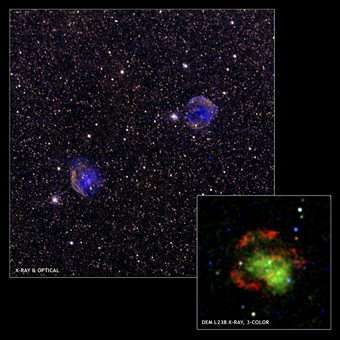X-ray Evidence Supports Possible New Class Of Supernova

Evidence for a significant new class of supernova has been found with NASA's Chandra X-ray Observatory and the European Space Agency's XMM-Newton. These results strengthen the case for a population of stars that evolve rapidly and are destroyed by thermonuclear explosions. Such "prompt" supernovas could be valuable tools for probing the early history of the cosmos.
A team of astronomers uncovered a puzzling situation when they examined X-ray data from DEM L238 and DEM L249, the remnants of two supernovas in a nearby galaxy. On the one hand, the unusually high concentration of iron atoms implied that the remnants are the products of thermonuclear explosions of white dwarf stars, a well-known type of supernova known as Type Ia. On the other hand, the hot gas in the remnants was much denser and brighter in X-rays than typical Type Ia remnants.
A white dwarf, the dense final stage in the evolution of a sun-like star, is a very stable object and will not explode on its own. However, if a white dwarf has a close companion star it can grow beyond a critical mass by pulling gas off the companion and explode.
Computer simulations of Type Ia supernova remnants showed that the most likely explanation for the X-ray data is that the white dwarfs exploded into very dense environments. This suggests that the stars which evolved into these white dwarfs were more massive than usual, because heavier stars are known to expel more gas into their surroundings.
"We know that the more massive a star is, the shorter its lifetime," said Kazimierz Borkowski of North Carolina State University, Raleigh. "If such a star could also begin to pull matter from its companion at an early stage, then this star would have a much shorter fuse and explode in only about 100 million years -- much less than other Type Ia supernovas."
Other teams have independently found evidence for prompt Type Ia explosions using optical observations, but at much greater distances where the environment of the stellar explosion cannot be probed. The X-ray data of DEM L238 and DEM L249 represent nearby examples of prompt Type Ia supernovas.
"We still need to know more about the details of these explosions since they are such an important tool for studying cosmology," said Stephen Reynolds also of North Carolina State University. "So, it's exciting to discover we have some really nearby examples, astronomically speaking, of this different class of explosion."
The luminosity of Type Ia explosions is thought to be very consistent from star to star, and astronomers have used observations of Type Ia supernovas in optical light as cosmic mile markers to study the accelerating expansion of the cosmos caused by dark energy.
If Type Ia supernovas can occur so quickly, they can exist much earlier in the Universe's history than generally believed, allowing them to probe the expansion at these epochs. Another possibility is that the prompt Type Ia's may also differ in other properties. If so, the assumption that Type Ia's are standard candles may be compromised, complicating attempts to study dark energy.
"We weren't around to see these stars before they exploded," said Sean Hendrick of Millersville University, Penn., "but these X-ray clues tell us that something unusual happened in the case of these two."
After finding this evidence for prompt Type Ia explosions in the Large Magellanic Cloud, a nearby galaxy, the researchers are looking at other supernova remnants within the Milky Way to see if they might be examples of this potential new class. For example, the famous supernova observed by Johannes Kepler in 1604 might have been a prompt Type Ia supernova.
Source: Chandra X-ray Center





















